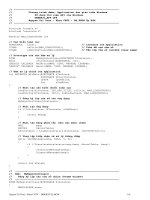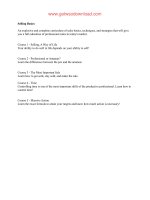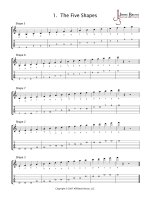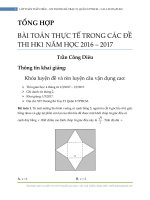10 1 numth annotated tủ tài liệu bách khoa
Bạn đang xem bản rút gọn của tài liệu. Xem và tải ngay bản đầy đủ của tài liệu tại đây (241.83 KB, 10 trang )
Online
Cryptography
Course
Dan
Boneh
Intro.
Number
Theory
Nota3on
Dan
Boneh
Background
We
will
use
a
bit
of
number
theory
to
construct:
• Key
exchange
protocols
• Digital
signatures
• Public-‐key
encryp3on
This
module:
crash
course
on
relevant
concepts
More
info:
read
parts
of
Shoup’s
book
referenced
at
end
of
module
Dan
Boneh
Nota3on
From
here
on:
• N
denotes
a
posi3ve
integer.
• p
denote
a
prime.
Nota3on:
Can
do
addi3on
and
mul3plica3on
modulo
N
Dan
Boneh
Modular
arithme3c
Examples:
let
N
=
12
9
+
8
=
5
in
5
×
7
=
11
in
5
−
7
=
10
in
Arithme3c
in
works
as
you
expect,
e.g
x⋅(y+z)
=
x⋅y
+
x⋅z
in
Dan
Boneh
Greatest
common
divisor
Def:
For
ints.
x,y:
gcd(x,
y)
is
the
greatest
common
divisor
of
x,y
Example:
gcd(
12,
18
)
=
6
Fact:
for
all
ints.
x,y
there
exist
ints.
a,b
such
that
a⋅x
+
b⋅y
=
gcd(x,y)
a,b
can
be
found
efficiently
using
the
extended
Euclid
alg.
If
gcd(x,y)=1
we
say
that
x
and
y
are
rela5vely
prime
Dan
Boneh
Modular
inversion
Over
the
ra3onals,
inverse
of
2
is
½
.
What
about
?
Def:
The
inverse
of
x
in
is
an
element
y
in
s.t.
y
is
denoted
x-‐1
.
Example:
let
N
be
an
odd
integer.
The
inverse
of
2
in
is
Dan
Boneh
Modular
inversion
Which
elements
have
an
inverse
in
?
Lemma:
x
in
has
an
inverse
if
and
only
if
gcd(x,N)
=
1
Proof:
gcd(x,N)=1
⇒
∃
a,b:
a⋅x
+
b⋅N
=
1
gcd(x,N)
>
1
⇒
∀a:
gcd(
a⋅x,
N
)
>
1
⇒
a⋅x
≠
1
in
Dan
Boneh
More
nota3on
Def:
=
(set
of
inver3ble
elements
in
)
=
=
{
x∈
:
gcd(x,N)
=
1
}
Examples:
1. for
prime
p,
2.
=
{
1,
5,
7,
11}
For
x
in
,
can
find
x-‐1
using
extended
Euclid
algorithm.
Dan
Boneh
Solving
modular
linear
equa3ons
Solve:
a⋅x
+
b
=
0
in
Solu3on:
x
=
−b⋅a-‐1
in
Find
a-‐1
in
using
extended
Euclid.
Run
3me:
O(log2
N)
What
about
modular
quadra3c
equa3ons?
next
segments
Dan
Boneh
End
of
Segment
Dan
Boneh









